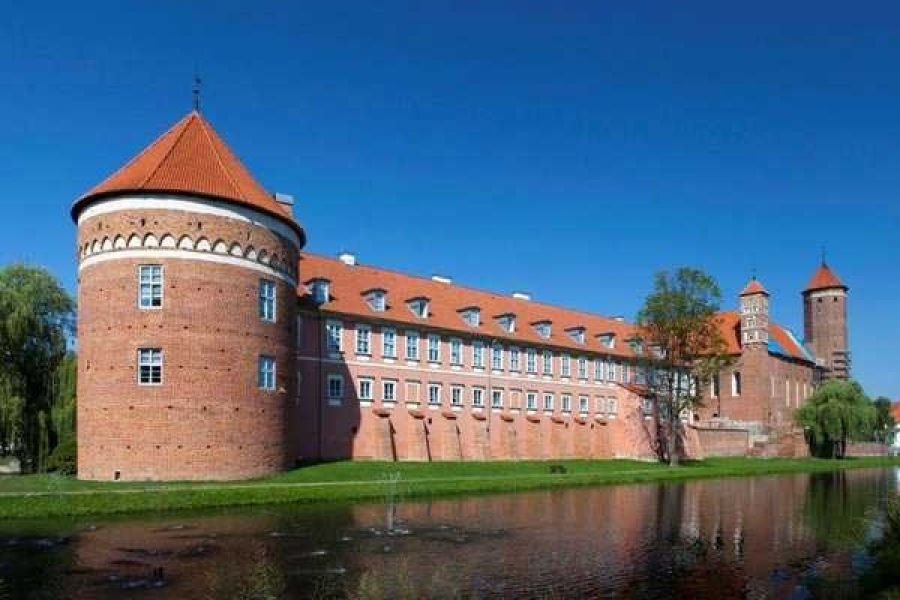The Warmian Museum in Lidzbark Warmiński
11-100 Lidzbark Warmiński
tel./fax.: 89 767 21 11
e-mail:
lidzbark@muzeum.olsztyn.pl
Description
The fame of the city are related to the decision to locate in this place, the permanent seat of the Warmian bishops, who from 1243 held a secular and spiritual authority. Dominium with an area of 4249,6 km2, remained until 1466 as a part of the Teutonic Order. The Lidzbark Castle was built in the years 1350-1401 on the site of a small Prussian town called Lecbarg, located in the arms of the Łyna and Symsarna rivers.
At the same time, the ward was also formed. In the south there were: stables, granaries and a coach house; in the northern (industrial): mill, sawmill, grindery, copper forge, fuller and tannery. The whole was surrounded by defense walls independent of the city and moats powered from the above-mentioned Symsarna. Under the provisions of the Second Peace of Toruń, Warmia was incorporated into Poland.
From then until 1795, famous Poles, outstanding representatives of Polish culture resided at the Lidzbark Castle: Łukasz Watzenrode, Nicolaus Copernicus, Jan Dantyszek, Stanisław Hozjusz, Marcin Kromer, Jan Stefan Wydżga, Andrzej Chryzostom Załuski, Adam Stanisław Grabowski, and Ignacy Krasicki. They created here a prominent cultural center, religious and political in opposition to the Lutheran princely court in Królewiec. From the end of the 16th century, the Lidzbark residence gradually lost its defensive character and transformed into a magnificent mansion, richly equipped with refined equipment, libraries and works of art.
Castle rooms have been adapted to new functions, dividing them into smaller ones and decorating them with richly painted paintings. In the years 1589-1599 Bishop Andrzej Batory to the wing of the northern castle added a palace - "cardinal rooms" (demolished in 1767). The next expansion was made by Bishop Jan Stefan Wydżga. His work was the Baroque palace (1666-1673) at the south wing, erected according to the Italian design by Issidore Affaiti. The last eight Polish bishops lived here. The annexation of the splendor of the episcopal residence was brought by the annexation of Warmia by Prussia in 1772.
The last bishop of Warmia, residing at the Lidzbark castle, was Ignacy Krasicki. After his departure in 1794, the abandoned building gradually deteriorates. Damaged in 1807 during the Battle of Lidzbark, devastated in 1812, when a barracks was located there, but it was successfully demolished by the Prussian authorities for demolition. At the turn of 1838 and 1839, the palace of Wydżga was demolished (the foundations preserved before entering the castle).
At the request of Bishop Józef Ambroże, Geritz, in 1857-1859, reconstruction and adaptation of the castle's rooms for the orphanage and the religious hospital, which was carried out by a construction adviser from Lidzbark Jesfer. The first comprehensive conservation works began in 1927. At that time, the Castle Museum was established.
After the Second World War, conservation works were completed. Their greatest intensity was in the years 1972-1973 and 1980-1985. The cultural activity of the castle was initiated in 1958 by the Socio-Cultural Association "Pojezierze". It was established in 1961 by the Warmian Museum, which from 1 January 1963 is a branch of the Museum of Warmia and Mazury in Olsztyn.
Photos provided courtesy of the Museum of Warmia and Mazury http://muzeum.olsztyn.pl/ .
Location
Pl. Zamkowy 1, 11-100 Lidzbark Warmiński



















Comments
comments powered by Disqus